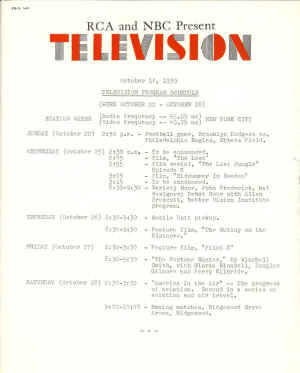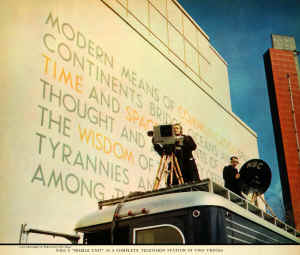|
|
RCA PRESS RELEASES FROM THE 1939
WORLD'S FAIR IN NEW YORK |
|
Do you have old historical
paperwork like this? Let us scan it
and put it online so everyone can benefit from the information. |

| PR-ES-10 5-39
RCA and NBC Present
TELEVISION
October 17, 1939
TELEVISION PROGRAM
SCHEDULE
(WEEK OCTOBER 22 - OCTOBER
28)
STATION W2XBS (Audio
frequency -- 45.25 mc) NEW
YORK CITY
(Video frequency -- 49.75 mc)
SUNDAY (October 22) 2:30 p.m. - Football
game, Brooklyn Dodgers vs.
Philadelphia Eagles, Ebbets Field.
WEDNESDAY (October 25) 2:30 p.m. -
To be announced.
2:45
- film, "The Lost"
2:55 - film serial,
"The Lost Jungle"
Episode X
3:05 - film, "
Midsummer In Sweden"
3:15 - To be announced.
8:30-9:30 - Variety Hour, John Frederick, hat
designer; Debut Hour with Allen
Prescott, Better Vision Institute
program.
THURSDAY (October 26) 2:30-3:30 -
Mobile Unit pickup.
8:30-9:30 - Feature film,
"The Mutiny on the
Elsinore."
FRIDAY (October
27) 2:30-3:30 - Feature film, "Pilot
X"
8:30-9:30 - "The Fortune
Hunter," by Winchell
Smith,with Gloria Blondell,
Douglas
Gilmore and Percy Kilbride.
SATURDAY (October 28)
2:30-3:30 - "America In the Air" - The progress
of aviation. Second in a series on
aviation and air travel.
9:00-10:00 - Boxing matches,
Ridgewood Grove
Arena, Ridgewood.
- - -
|
|
| |
| PR-ES-I0 5-39
RCA and NBC Present
TELEVISION
October 17, 1939
TELECAST RECEIVED IN PLANE OVER
WASHINGT0N IN RCA 20TH ANNIVERSARY DEMONSTRATION
New York Signal Is Picked Up 21,600 Feet Over
Capital With Ordinary Receiver
Television in the substratosphere, more than four miles above
Washington, D.C., made history today when the Radio Corporation of America
and the United Air Lines cooperated in successful reception of images
broadcast from New York more than 200 miles to the north.
The experiment marked the twentieth
anniversary of the founding of RCA.
Flying over the nation's capital at an altitude
of 21,600 feet, engineers of
RCA and the National Broadcasting Company tuned in Station W2XBS
in New York. At the appointed the image of Herluf Provensen, NBC
announcer, appeared on the screen. Those of David Sarnoff, president of the
Radio Corporation of America, and W.A. Patterson, president of United Air
Lines, appeared shortly thereafter.
By means of two-way radio communication, members of the party making
the flight were able to talk with Mr. Sarnoff and Mr. Patterson in the
studio at Radio City. In response to a request from a photographer in the
plane, Mr. Sarnoff held a post for a picture off the Iconoscope screen of the
receiver. (Editors note should this be
'pose' not post?)
As the plane soared above the 16,000-foot level, representatives of United
Air Lines supplied each of the group, consisting mainly of York
newspapermen, with tubes through which they could breathe in enough oxygen
to offset the effects of the high altitude. As the television images continued
to appear on the screen of the receiver, the windows of the plane frosted
over. The outside temperature was registered at about ten degrees Fahrenheit.
(more)
-2-
The photographs made over Washington probably recorded the all time
long distance record for photography. Sarnoff and Patterson and Provensen
were more than 200 miles distant at the time. Pictures were made by Sidney
Desfor, of the National Broadcasting Company photo staff. The most
thrilling moment of the television flight came on the return from
Washington, A few minutes out of North Beach Airport the motion picture
transmission suddenly stopped and in its stead there appeared the image of
the approaching plane circling the new airport. "There 'we are!"
cried the passengers. The television cameras followed the ship until it
touched the earth and taxied up to the runway to a stop.
The images, as seen in the plane, were comparable to those received in
the primary service area of the NBC station, which reaches out fifty miles
in all directions from midtown Manhattan. Frequently, however, they
suffered from interference of other electrical equipment in the plane,
including the radio transmitter and ignition apparatus for the ship's two
motors.
Ralph Holmes, RCA engineer, and W.A.R. Brown, NBC engineer, explained
that the intensity of the signal at 200 miles distance from the
transmitter was low, and that interference, however slight, had serious
results in impairing image quality. On the return trip, approaching New
York City, where the signal became strong, motion picture transmissions
and the landing of the plane itself at North Beach Airport were in sharp
focus.
Today's experiment, employing the transmission equipment of the National
Broadcasting Company, bore out the theory that the ultra-short waves used
in television travel in comparatively straight lines. In order to receive
the telecast over Washington, D.C., the United plane was forced to rise
above the 16,000-foot altitude level.
( more )
-3-
Television engineers had previously established that the ultra-short
wave's utility was over an area roughly limited by the visual horizon.
The receiver was a standard model now being sold in New York.
The only change made in it was a slight adjustment in the automatic
volume control to compensate against the whirling propellers.
These, according to engineers, acted as reflectors, causing extremely
rapid variations in the intensity of the received signal. The antenna used
was a simple dipole type, consisting of two wires strung under the
fuselage of the ship. The connection to the receiver was made through the
fuselage.
When the plane landed at Washington, representatives of the Army
and Navy departments, the Federal Communications Commission and Civil
Aeronautics Authority, as well as several newspapermen, were taken up to
witness a repeat of the unusual experiment.
- - -
|
| |
| PR-ES-10 5-39
RCA and NBC Present
TELEVISION
October 17, 1939
$500,000 IN FURS TELEVISED
A half-million dollars worth of rare furs, including the only two
Belvedere furs in the world, which have been collected by 1. J. Fox, will
be televised by the National Broadcasting Company over Station W2XBS on
Friday, Oct. 20, at 2:30 p.m.
Max Bachrach, an authority on furs, will act as commentator. He also
will answer questions posed by Lynne Lorayne, fashion editor of the New
York Journal American. Among the costly furs to be shown are a russian
sable coat valued at $25,000, an albino beaver, silver foxes and other
rare pelts.
The Belvedere furs, costing $4,000 a pair, were developed more than 12
years experimentation in cross-breeding silver and white foxes.
- - -
AUTOMOBILE REVIEW ON TELEVISION
Thirty-seven years of automotive pioneering will be spanned by NBC
Television on Thursday, Oct. 19, when an automobile review at the Ford
Exhibit at the New York World's Fair is televised over Station W2XBS from
2:30 to 3:30 p.m.
A progression of autos, from the first gas-buggy built in 1903, to the
stream-lined production of today, will pass before the television cameras.
All of the cars, which have been taken from the Ford Exhibit, will operate
under their own power, with drivers garbed in the costume of the era of
their vehicles.
- - -
|
| |
National Broadcasting Company
RCA Building, Radio City, N. Y.
October 17, 1939
PHONETIC TYPEWRITER USED AT NBC IN
COMPILING ANNOUNCERS' GUIDE
Task of Preparing Handbook
Now Nearing Completion
Our archaic system of spelling, which dates back to Shakespeare's day,
will be "translated" into the vowels and consonants actually
used in modern English speech by means of a phonetic typewriter just
completed for the National Broadcasting Company.
The machine, an ordinary typewriter except for the fact that it has 90
strange symbols on its type bars, was made under the direction of Dr.
James F. Bender, chairman of the department of speech at Queens College,
Flushing, L.I., and director of information for the American Speech
Correction Association. It was built by the L.C. Smith Company in order
that a legible manuscript could be prepared for NBC's forthcoming
"Handbook for Announcers and Speakers," of which Dr. Bender is
editor. It also may be used in preparing scripts for broadcasts which
contain unusual technical phrases, foreign place names, etc.
"A phonetic alphabet has become an absolute necessity when dealing
with English and American pronunciation because our spelling has become
outmoded," says Dr. Bender. "In other words, while spelling has
changed very little in 300 years, pronunciation has undergone several
decided shifts.
"Then too, our system of spelling is non-phonetic. For example, we
may turn to the morning paper and read at random such words as father,
ball, hat, made and ask. Although all these words have a common letter
(a), that letter represents a different sound in each word.
(more)
-2-
Only by using the recently developed International Phonetic Alphabet
can we represent these differences and set up a definite standard of
pronunciation for radio." The NBC Handbook, which is nearing
completion after three years of study and preparation, will contain a
foreword explaining what NBC considers the basic requirements of good
radio addresses, and introductory chapters by Dr. Bender on such things as
the principles of radio speech and proper introductions, as compiled from
a manual published by the Division of Protocol in Washington.
The body of the book is to consist of a list of 15,000 words frequently
mispronounced or misused. Ten thousand of these were gathered by NBC from
Lawrence Abbott, assistant to Walter Damrosch in the
music department; Patrick J. Kelly, NBC supervisor of announcers, and
Noran E. Kersta in Television.
The rest were supplied to Dr. Bender by the secretaries of various
embassies and legations in Washington, and by the Associated Press, United
Press Association and International News Service. These are international
in scope, due to the constantly shifting news developments abroad. All
words in the handbook list will be printed in three ways: as ordinarily
spelled, syllabized with pronunciation marks found in most school
grammars, and in the International Phonetic Alphabet. "It was decided
to use phonetic transcriptions because they are most satisfactory for the
student of pronunciation," says Dr. Bender. "Also, they will
appeal to teachers and students of speech throughout the country, since
phonetics is rapidly becoming the main vehicle for speech
improvement."
|
| |

N.B.C.'s 'mobile unit' is a complete television station in two trucks
Otto Hagel
|